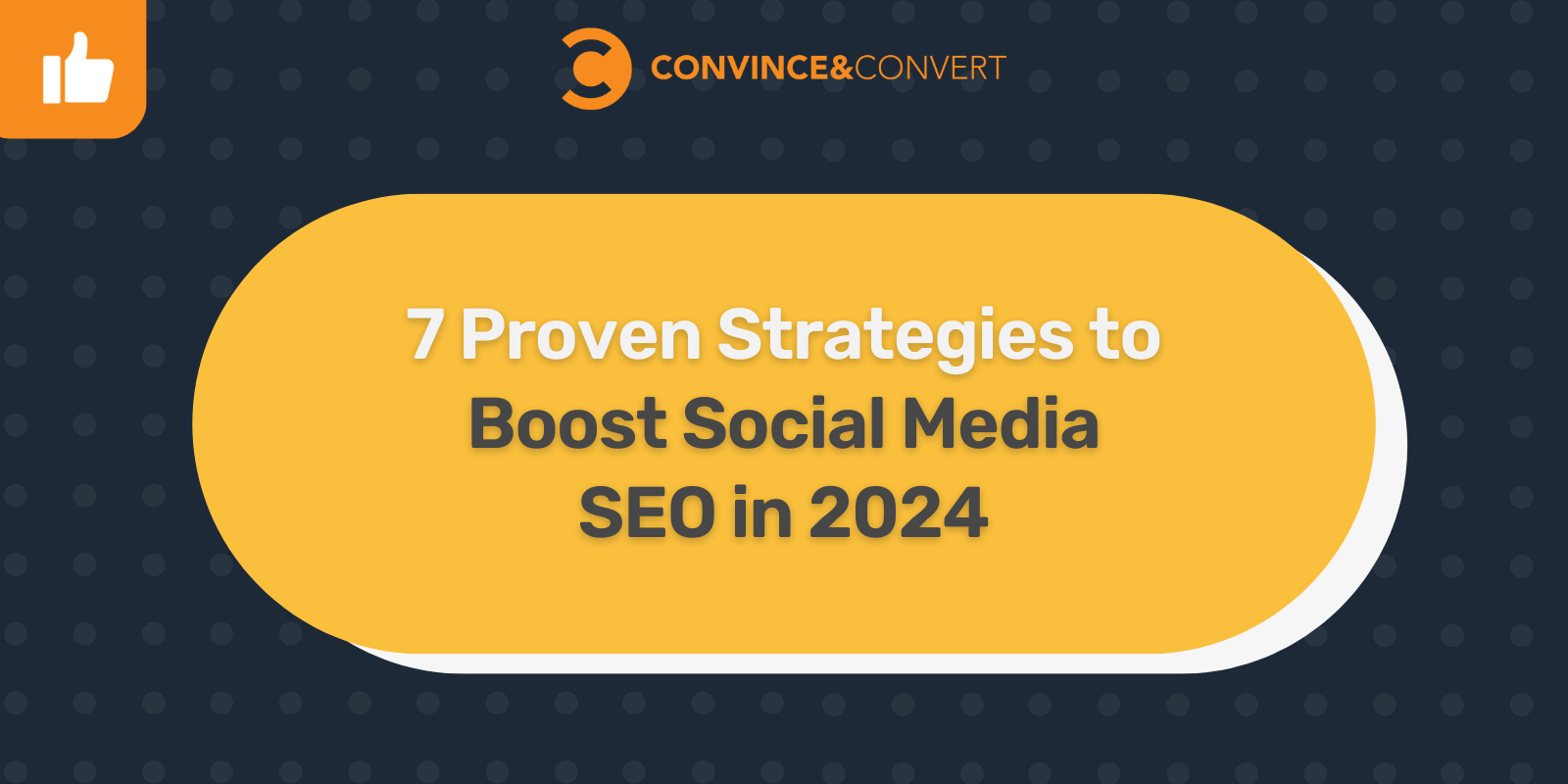
Gone are the days when SEO was important just for the SERP.
User behavior is changing, and studies show that around 31% of consumers use social media channels to find answers to their queries. The millennials and Gen Z are among the top groups driving this change, and it’s projected to grow over time.
If you’re growing your business and footprint online, this is the best time to understand social media SEO. It’ll help you create a loyal community of followers and promote your page and business.
We’ve compiled an updated list of the best tips you must know before you begin optimizing your online presence.
What is social media SEO?
Social media SEO is optimizing your social media channels for reach and visibility to help you drive brand awareness, build trust, and contribute to generating leads. You rank higher on search engine results, which drives more clicks to your profile and content.
At the core of SEO is directing the audience towards the most relevant content, businesses, and individuals. The SEO of search engines and social media matter equally in creating a trustworthy brand identity.
Your audience is more aware now than ever before and taking every decision after considerable research. By optimizing for search results, you can make your social media posts and profiles land on their search results on every channel. And repeated exposure to your content and your strong presence on these platforms will compel them to choose you over your competitors.
To effectively promote your services, eCommerce or Shopify store, leveraging social media SEO strategies can significantly enhance your online visibility and attract more potential customers.
Here’s a list of top tips to make the most of your content creation efforts:
7 tried-and-tested tips to leverage social media SEO
You need to take basic and advanced actions to secure the top position on social media search results. Here’s how you can direct your efforts for maximum reach and visibility:
1. Optimize your social profiles for search
All social media platforms, be it LinkedIn, Instagram, X, or Facebook, have a search feature. Optimizing your profile headline will ensure that your account comes up in the first few positions and gets more clicks when your prospects search for your service, product, or industry.
Here’s an SEO-friendly profile headline template for you:
Results you’ve generated or remarkable experience you’ve had | Your role at Company/Industry | Skill/Product/Service you offer | Call to action
Sam Browne, who offers LinkedIn coaching services for entrepreneurs, has used the same format for his LinkedIn headline:

This template lists all the essential details about what you do and how you help. You can use industry-standard keywords and grab attention with your distinct achievements. This method is one of the most important strategies for LinkedIn marketing.
Tip for Founders: If you are building a product or service, don’t forget to add it to your headline.
Here are two ways it helps:
- Attracts people towards your journey: The audience loves transparency and connects really well when they witness the highs and lows of the process. In fact, building in public is a great way to attract beta clients and customers.
- Invites engagement, opinions, and reviews: It encourages comments and engagement on your content, boosting your SEO. By the time you launch your first offer, you’ll have enough positive comments and word of mouth to drive initial sales.
Tim Hanson is doing the same. He’s building an AI tool for writing and collecting his first set of users with a discount. Take a look at his headline:

2. Build a keyword strategy and content clusters
A well-defined keyword strategy will help social media search engines understand the topics of your expertise and rank your content and profile for those queries.
For example, keyword research tells you that the search volume and competition are high for “personal branding” and relatively low for “personal branding for black entrepreneurs.” If you’re part of the black community, you should be focusing on the latter, as it’s less competitive and will yield results for you faster.
Your keyword strategy will depend on your:
- Product or service offering and USP
- Overall marketing goals
- Your current SERP position
- Audience group you want to target
- Competitors with similar offerings
- Search volume and intent of the target keywords
- Your resources like time, budget, skills and tools
As a part of your social media strategy, make content clusters under each topic using keyword analyzing tools like Ahrefs or Semrush. Here’s an example:
Imagine you’re a founder of a time management software and one of your content pillars is time management. Under this bucket, make content around longer and shorter keywords like:
- Time blocking
- Productivity for entrepreneurs
- Time management techniques
- Goal setting tips
3. Strategically use hashtags to gain visibility
Hashtags aren’t dead, as most people want to believe. But the way you use them has changed. There were days when each Instagram or LinkedIn post had 15 or more hashtags and people used them based on popularity and what was going viral.
Now, it’s completely different. As algorithms have become smarter, it reduces the impressions of those posts that have too many spammy or unrelated tags.
Here’s the thing— hashtags exist to help social media platforms find the most relevant content pieces for their audience. You have to use social listening to find the most relevant hashtags for your audience.
Use these additional tips to find the best ones for you:
- Don’t use too many of them. Aim for three to five in each post.
- Eliminate spammy or banned ones. They’ll get your posts deleted or simply won’t appear in people’s feeds.
- Use most relevant hashtags—the ones that best describe your post
- Avoid using too long or extremely crowded tags.
Alternatively, you can use hashtag generating tools and cut down on guesswork and time spent on research.
4. Add links to direct users to your website
There are several reasons why you should be adding links of your website on your social channels:
- It increases traffic and visibility of your website
- Improves customer experience by helping them find and choose you
- Boosts brand authenticity
Even well known brands like Semrush swear by adding links:

You don’t essentially have to link to your website’s homepage from your bio.. Here are other alternatives and why they work:
Alternative 1: If you are running special offers or deals, add a link to your webpage that displays the offer.
Why it works: Adding offer links reduces resistance for your users and makes it more accessible.
Alternative 2: If you have achieved a milestone and have created a case study for your readers, link it to your social media page.
Why it works: This establishes authority and generates leads for your business.
5. Include social sharing options for website content
You are spending a ton of your resources on creating website content like blogs, whitepapers, use cases and case studies. But if it’s not shareable, you’re diminishing your efforts.
Everyday, your audience is scouring through the search engine to find relevant information. If they find something valuable on your website and want to share it on their social media or with their teams, you should ensure that it’s easy for them.
Apart from boosting SEO, you can maximize ROI on each content piece and attract leads with your content efforts.
Akiflow, a time and task management tool, nails this by adding social media links at the bottom of each blog post. Take a look:

6. Increase content publishing frequency
If someone is telling you that quality is the only important thing, then in 2024 they’ll be furthest away from reality. Quality and quantity are two sides of the same coin, and you need both to win the SEO race.
Quality ensures that you address pain points, satisfy search intent and develop trust in your audience by delivering guaranteed value.
Quantity means showing up on your social media channels often to leave a mark on the audience while telling the algorithm that you’re active, relevant and care to deliver quality. Begin by posting three to five posts per week and build towards posting every day.
Justin Welsh’s LinkedIn is a great example to help you understand the impact of consistency. He posts daily:

Justin has grown his LinkedIn following close to 500 thousand by coupling his strategy with a consistent publishing frequency.
Here’s how you set yourself up for consistency:
- Prepare a social media strategy to begin with. It’ll determine your pillar topics, publishing frequency and approach to driving engagement.
- Analyze your USP and the content of your competitors. Based on these insights, start batch-creating content in advance.
- Schedule posts in advance using management tools. It’ll cut down on the chances of missing the posting time.
Next time you hear of a business or individual with a great post reach and a large following, know that a big part of their strategy has been ensuring consistency.
7. Published search-optimized content
Here’s what a publishing journey looks like: Publish—Track—Analyze—Repeat!
Once you publish SEO friendly content on your pages, the next step is to track the KPIs of your posts. The secret sauce is to track and analyze your social media pages as well as your best and worst performing posts. You’ll be able to see what format, hook, CTA, posting time and visuals are working for you and what’s not.
On top of that, you must measure these metrics for a holistic idea:
- Followers
- Impressions
- Engagement
- CTR (click through ratio)
- Bounce rate
- CPC (cost per click)
Make sure you compare these numbers to your competitors’s numbers and industry standards to get a better contextual idea.
Alternatively, you can use social media tracking tools to create, schedule, track and analyze numbers. Here are some tools worth considering:
- Hootsuite: It’s a marketing and management tool to help you track organic, paid and web metrics side by side.
- Sprout Social: It’s an all in one tool to guide your social media strategy as well as analyze numbers.
- Mention: It brings all metrics to your fingertips and enables teams to monitor related data.
- Buzzsumo: It helps you research and generate ideas, track metrics, find influencers for brand deals and automate your tasks.
Build your social media SEO strategy today
SEO is your key to unlock maximum visibility among the right audience. When combined with social media, SEO can amplify your brand message and build a community of happy customers.
With the right strategy, research and tools, you can ace social media SEO and become an industry-leading brand. Maximize your marketing efforts by optimizing for SERP and social media, both. There’s no better time to do it than now.


